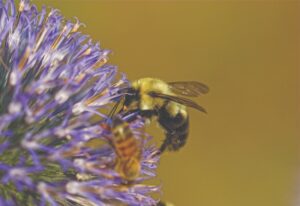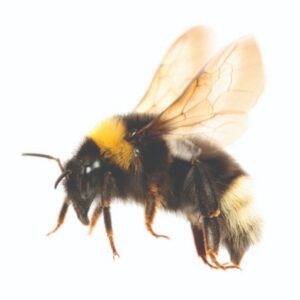Do you know the difference between good and bad stinging insects?
In support of promoting Pollinator Health Awareness, there’s no better time to differentiate what is considered a good bee versus a bad one. Preserving helpful pollinator populations of honey bees, butterflies, even bats is so important. While all of the insects profiled in this article are capable of stinging you, there are only a few that are health threats.

Bumble bee and honey bee on flower, courtesy of NPMA
Protecting Health for humans and pollinators
Now is the time to enjoy what’s left of the warm weather, sunshine and the great outdoors, but it’s also the time when stinging insects can make an appearance at picnics, cookouts and pool parties. Franklin Pest Solutions, servicing Northwest Indiana, warns that yellow jackets, wasps, hornets and other common stinging insects can pose an increased threat to one’s health. In fact, they send more than half a million people to the emergency room every year, according to the National Pest Management Association.
“From painful stings to severe allergic reactions, stinging insects can put a damper on outdoor fun,” said Wayne Magnuson, Safety & Training Manager for Franklin Pest Solutions. “Whether you plan to fire up the grill, go to the playground or relax by the pool, it’s important to be aware of the risks posed by certain stinging insects.”
Good bee vs. Bad bee
Below are the profiles of wasps, bees, and hornets native to our region. Perhaps this will clear up any wasp vs hornet confusion!
Yellow jackets – Yellow jackets are distinguished by the black and yellow color pattern banded across their abdomens. They are territorial and may sting repeatedly if threatened.
European Hornets – European hornets are active at night. They have smooth stingers that carry venom known to cause itching, swelling and pain for about 24 hours. Like yellowjackets and wasps, European hornets can sting repeatedly during an attack.
Paper Wasps – Paper wasps are not an aggressive species by nature, but they will sting if their nest is threatened. Wasp stings are painful and can cause the same risk of allergic reaction as other insect stings.
Bumble Bee – Not as aggressive as the other guys, but will defend nests. They’re fuzzy and big and are GOOD pollinators!
Honey Bee – Docile, unlikely to sting, super important to our food supply as pollinators. Colonizes in hollow trees, walls or attics. We do not kill honey bees and love what they do for us! <3

bee in flying on white
So Who Brings the Sting?
Angie’s List put out a great infographic, illustrating all the different kinds of stingers in our area and how much of a threat they are to us. Check it out!
“The best way to prevent an unwanted encounter is to exercise caution when outdoors. If you come in contact with a bee or wasp, do not swat it, as that may actually provoke an attack. Remain calm and the insect should fly away without causing harm,” added Magnuson.
Want a free quote on protecting your home and family from bad stingers? We have solutions!
| {{cta(‘3063c796-5c28-4b9e-a8e2-49cbfd054e64’)}} | {{cta(’03e7974a-bb7a-46b7-b0fd-0bf63c183240′)}} | {{cta(‘f9d2dc82-6ee0-4fa7-bbd7-e50c32c5f90b’)}} |






